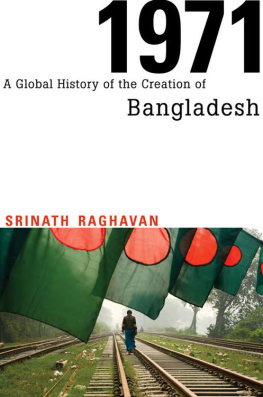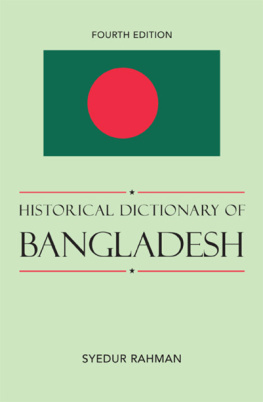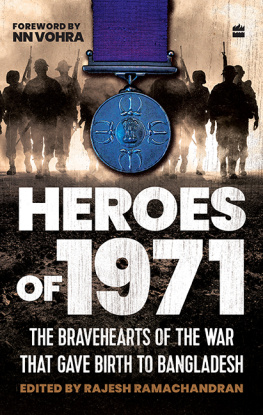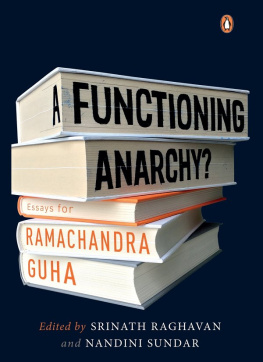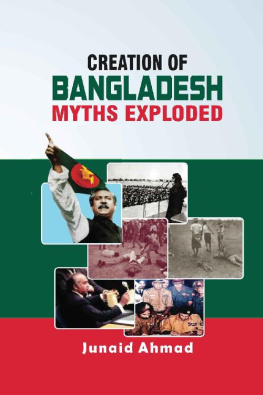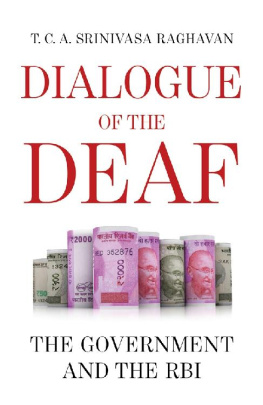Srinath Raghavan - 1971: A Global History of the Creation of Bangladesh
Here you can read online Srinath Raghavan - 1971: A Global History of the Creation of Bangladesh full text of the book (entire story) in english for free. Download pdf and epub, get meaning, cover and reviews about this ebook. year: 2013, publisher: Harvard University Press, genre: Politics. Description of the work, (preface) as well as reviews are available. Best literature library LitArk.com created for fans of good reading and offers a wide selection of genres:
Romance novel
Science fiction
Adventure
Detective
Science
History
Home and family
Prose
Art
Politics
Computer
Non-fiction
Religion
Business
Children
Humor
Choose a favorite category and find really read worthwhile books. Enjoy immersion in the world of imagination, feel the emotions of the characters or learn something new for yourself, make an fascinating discovery.
- Book:1971: A Global History of the Creation of Bangladesh
- Author:
- Publisher:Harvard University Press
- Genre:
- Year:2013
- Rating:4 / 5
- Favourites:Add to favourites
- Your mark:
- 80
- 1
- 2
- 3
- 4
- 5
1971: A Global History of the Creation of Bangladesh: summary, description and annotation
We offer to read an annotation, description, summary or preface (depends on what the author of the book "1971: A Global History of the Creation of Bangladesh" wrote himself). If you haven't found the necessary information about the book — write in the comments, we will try to find it.
1971: A Global History of the Creation of Bangladesh — read online for free the complete book (whole text) full work
Below is the text of the book, divided by pages. System saving the place of the last page read, allows you to conveniently read the book "1971: A Global History of the Creation of Bangladesh" online for free, without having to search again every time where you left off. Put a bookmark, and you can go to the page where you finished reading at any time.
Font size:
Interval:
Bookmark:
1971
1971
A GLOBAL HISTORY OF THE CREATION OF BANGLADESH
Srinath Raghavan
Harvard University Press
Cambridge, Massachusetts
London, England
2013
Copyright 2013 by Srinath Raghavan
All rights reserved
Jacket photo: Dhaka, Bangladesh/ Mohammad Moniruzzaman/Corbis
Jacket design: Jill Breitbarth
The Library of Congress has cataloged the printed edition as follows:
Raghavan, Srinath.
1971 : a global history of the creation of Bangladesh / Srinath Raghavan.
pages cm
Includes bibliographical references and index.
ISBN 978-0-674-72864-6 (alk. paper)
1. BangladeshHistoryRevolution, 1971. 2. India-Pakistan Conflict, 1971. 3. South AsiaPolitics and government. I. Title. II. Title: Global history of the creation of Bangladesh.
DS395.5.R199 2013
954.9205'1dc23 2013012267
To my parents
CONTENTS
It is very bad with your prime minister, blurted the burly Russian guard to the private secretary, It is very bad. By the time the secretary rushed to the bedroom the prime minister of India, Lal Bahadur Shastri, was dead. It was a little past midnight in Tashkent on 11 January 1966. Less than twelve hours ago, Prime Minister Shastri and President Ayub Khan of Pakistan had agreed on a declaration restoring status quo ante between their countries after the war of 1965. The declaration had formally been inked in the presence of Premier Alexei Kosygin of the Soviet Union. Now it was Kosygins turn to sign the condolence book placed near the deceased prime minister.
Later that morning, the casket mounted on a gun carriage and ringed with wreaths began moving toward the airport. The seventeen-kilometer route was lined by the citys mourning residents and flanked by Indian, Pakistani, and Soviet flags flying at half-mast, draped in black. At the airport, Ayub Khan joined the Soviet leaders in paying final homage to Shastri. As the casket was lowered from the carriage, Ayub and Kosygin stepped forward and became the lead pallbearers. When the coffin was placed on the gangway of the aircraft, the Red Army band sounded the funeral dirge, and Soviet soldiers reversed their arms. At 11 AM , the aircraft took off for New Delhi.
None witnessing this tragic yet remarkable scene on that icy morning would have contemplated the possibility of another India-Pakistan war any time soon. The 1965 war was not, of course, the first conflict between the two countries. India and Pakistan had been rivals from the moment of partition and independence in August 1947. A few months later, the two neighbors were at war over the princely state of Jammu and Kashmir. The ceasefire agreement of January 1949 left the state divided between the belligerents. Although the dispute continued to simmer, the ceasefire held for sixteen years. India sought no more than to cement the status quo. Given the asymmetry of power between the two countries as well as Indias willingness to flex its military muscle, Pakistan refrained from using force to wrest Kashmir.

This prudent policy was jettisoned by the Pakistani leadership following a standoff with India over the Rann of Kutch in early 1965. Emboldened by Indias tepid response to this crisis, Ayub Khan authorized a covert invasion of Kashmir that escalated into all-out war. When the ceasefire was brokered, Indian forces were in control of territory ahead of Indias western borders with Pakistan. The Tashkent agreement not only restored the territorial status quo but also stipulated against the use of force in resolving outstanding disputes. In consequence, the negotiators at Tashkent could look forward to another long spell of armed peace.
The conclusion of this agreement in Tashkent underscored the interest of the superpowers in preserving peace in the subcontinent. Indeed, superpower encroachment had been an endemic feature of postcolonial South Asia. In the early years after decolonization, the United States preferred to follow Britains lead on subcontinental affairs. In the wake of the Korean War, the United Statesfearing a Soviet thrust into the Middle East and desirous of tapping into Pakistans military potentialconcluded a defense pact with Pakistan in 1954. By the end of his term in office, President Dwight Eisenhower was ruing the damage wrought on US-India relations by his decision to arm Pakistan. When war broke out between India and Pakistan in August 1965, the Johnson administrationknee-deep in the bog of Vietnamadopted a plague-on-both-your-houses attitude, imposing an arms embargo on the antagonists and allowing the Soviet Union to forge a postwar settlement.
The Soviet Union was a relatively late entrant to the geopolitics of South Asia. Not until the advent of Nikita Khrushchev in 1953, with his emphasis on peaceful coexistence to woo the postcolonial states, did South Asia acquire importance in Moscows eyes. This led to an upswing in relations with India, which coincided with a downturn in Moscows relations with Pakistan owing to the latters entry into US-led alliances. By the end of the 1950s, the Soviet Union was the one great power that supported India in the Kashmir dispute.
From late 1964 onward, there was a gradual shift in the Soviet outlook toward Pakistan. The backdrop to this was the rift between the Soviet Union and China. Moscow watched with concern as China drew close to Pakistan after the Sino-Indian war of 1962. The emerging Sino-Pakistan entente prompted the Russians to invite Ayub Khan to visit Moscowthe first visit at this level. Ayubs trip in April 1965 led to a thaw in Soviet-Pakistan relations. When Prime Minister Shastri visited Moscow seeking Soviet support on the Rann of Kutch, General Secretary Leonid Brezhnev observed that every question like a medal has two sides to it.
And yet India and Pakistan were at war inside of six years. More intriguingly, the war was fought not over Kashmir but over the eastern wing of Pakistan. The West Pakistani military regimes use of force to suppress a popular movement for independence in East Pakistan led to a massive exodus of refugees to India and eventually to an Indian military intervention. The war of 1971 was the most significant geopolitical event in the subcontinent since its partition in 1947. Few contemporary conflicts have been so brief and localized but had such protracted and global ramifications. At one swoop, it led to the creation of the large and populous state of Bangladesh, and tilted the balance of power between India and Pakistan steeply in favor of the former. The consequences of the conflict continue to stalk the subcontinent. The Line of Control in Kashmir, the nuclearization of India and Pakistan, the conflicts on the Siachen Glacier and in Kargil, the insurgency in Kashmir, the political travails of Bangladesh: all can be traced back to nine intense months in 1971.
For the peoples of South Asia, the conflict has not really finished. For historians, it has barely begun. To be sure, the guns had hardly fallen silent when the first accounts by journalists and analysts began to be published. Hundreds more have been written in the four decades since. Although this body of writing remains important, there are remarkably few books that provide a historical account and explanation of the crisis and war of 1971. Most existing accounts lack the detachment and distance as well as the sources that make for good contemporary history. A superb exception to this trend is Richard Sisson and Leo Roses War and Secession . Drawing on interviews with key participants in Bangladesh, Pakistan, and India, the authors presented an excellent and scholarly account that rose above the partisanship of the literature.
Next pageFont size:
Interval:
Bookmark:
Similar books «1971: A Global History of the Creation of Bangladesh»
Look at similar books to 1971: A Global History of the Creation of Bangladesh. We have selected literature similar in name and meaning in the hope of providing readers with more options to find new, interesting, not yet read works.
Discussion, reviews of the book 1971: A Global History of the Creation of Bangladesh and just readers' own opinions. Leave your comments, write what you think about the work, its meaning or the main characters. Specify what exactly you liked and what you didn't like, and why you think so.

